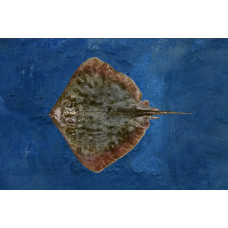Latin name
Hemitrygon parvonigra
Other names
Hemitrygon parvonigra
Identification
These rays have a pointed snout in the shape of a broad triangle. Behind the large protruding eyes are the spiracles, bigger than eyes are in size. On the ventral surface of the disk are 5 pairs of S-shaped gill slits, a mouth and oval nostrils. A flap of skin with a fringed lower edge runs between the nostrils. The medium-sized mouth is arched, with 4 protuberances at the base of the mouth and a tiny protuberance at the corners of the jaws.
The whiptail is 1.5 times longer than the disc. It has a rather broad and flattened base. As in other whiptails, there is a serrated spine on the dorsal surface in the central part of the tail stalk, which is connected by ducts to the venom gland. Sometimes whiptails have two spines. Periodically, the sting is broken off and a new one grows in its place. Behind the spike on the caudal peduncle is a long ventral and short dorsal skin fold. From the head, a short row of closely spaced, lance-shaped spines runs down the back. Each "shoulder" also bears 1-2 small, granular barbs. In front of the venomous sting, there is also a row of large barbs along the midline of the tail.
Teeth
The teeth are staggered and form a flat surface. The mouth has about 43 rows of teeth on each jaw. The central teeth end in long, thin spines.
Features of fish fins
The pectoral fins fuse with the head to form a diamond-shaped flat disk, slightly wider than long, with rounded fins ("wings"). The edges of the small pelvic fins are nearly straight. Males have flattened pterygopod.
Fish colouring
The dorsal surface of the disc is various shades of brown. Edges, area covered with barbels, and tail posterior to spine are lighter than main coloration. Ventral surface of disc white.
Distribution
Occurs off the northwest coast of Australia (north of Port Hedland), Indonesia, including Bali, Sabah and Borneo, and Malaysia.
Habitat
Marine brackish benthopelagic tropical species. They occur on the outer part of the continental shelf at depths from 125 to 185 m. On the island shelf of Indonesia they occur at shallower depths, from 60 to 125 m.
Size
Maximum recorded disk width is 51 cm (49.8 cm for females) and length is 1.1 m. Maximum length for females of similar build is up to 49.8 cm wide.
Behavior
They lead a bottom-dwelling lifestyle.
Food and feeding habits
The diet consists mainly of mollusks, worms, crustaceans and fish.
Reproduction
This species is probably a placental viviparous species, and the developing embryos, as in other stingrays, feed on histotrope produced by the mother. Males reach sexual maturity at about 35 cm (14 inches) in diameter.
Fishing
Not a targeted fishery. They are caught as bycatch in commercial trawl and seine fisheries and sold for meat.
Relationship with a person
It is a species that is harmless to humans.
| Classification | |
| Phylum | Chordata |
| Class | Chondrichthyes |
| Squad | Myliobatiformes |
| Family | Dasyatidae |
| Genus | Hemitrygon |
| Species | H. parvonigra |
| Features | |
| Conservation status | Data Deficient |
| Habitat | Bottom |
| Life span, years | No information |
| Maximum length, cm | No information |
| Sailing speed, m/s | No information |
| Threat to people | Edible |
| Way of eating | Predator |
Dwarf black stingray
Tags: dwarf black stingray

